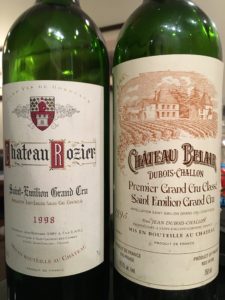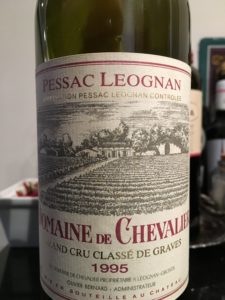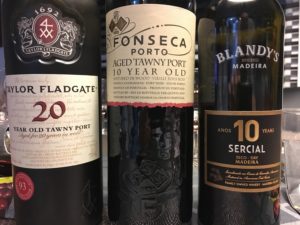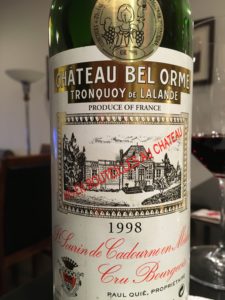Happy 2019, fellow wine lovers! I for one will not be sorry to see the back of 2018. It was a rather nasty year globally, somewhat ameliorated in our household at least by sharing some wonderful wines. During the holiday season just passed, I pulled the corks on some mostly older wines that had been patiently waiting for their moment in – well, if not quite the sun, at least the light of day. Herewith my tasting notes:
Two different Saint-Emilion chateaux showed two versions of what happens to Merlot (the dominant grape in this Right Bank Bordeaux appellation) as it ages:
Chateau Rozier 1998, Saint-Emilion Grand Cru was soft and delicate, with fading black fruits and tertiary notes of forest floor, mushroom and dried-up dustiness, but not too much else. At 20 years, it was clearly done and would have been fresher five or six years ago. Oh well…
Chateau Belair 1995, Saint-Emilion Premier Grand Cru Classé was a decent brick red colour, and had some sediment (decanted). It had a savoury, dusty nose of blackberry, forest floor, leather and mushroom, and an earthy dustiness on the palate with fading black fruits and a strong acidic backbone. Smooth and linear rather than opulent or ripe, it epitomized fading elegance. Grace over power.
This chateau is located next to famed Chateau Ausone on prime Saint-Emilion terroir, and was classified as a Premier Grand Cru Classé B in the original Saint-Emilion classification of 1958. Since 2008 it has been part of the JP Moueix stable and is now sold under the Chateau Belair-Monange name. The 1995 vintage was one of the last made here by the great Pascal Delbeck, who also made the wines at Ausone back in those days.

Domaine de Chevalier 1995, Pessac Léognan, Grand Cru Classé de Graves is another venerable wine estate, this time from the other side of the river (Left Bank), located just south of Bordeaux in the famed Graves wine region and just about as far west as you will find vineyards before the great Forêts des Landes begin. It has a privileged reputation for both its red and white wines, and is something of an outlier, hidden at the edge of the forest with a unique terroir, and holding to its own tried-and-tested methods of wine production.
Here Cabernet Sauvignon is dominant in the blend. The 1995 had an impressive garnet colour given its 23 years of age. The nose offered impressive intensity with aromas of blackberry, cassis, forest floor, tar, iodine and dark chocolate. The wine had quite pronounced acidity with smooth, fine-grained tannins and savoury, fully developed flavours of black fruits, cassis, forest floor, tarry smoked meats, leather and mocha. It finished elegant and light, in a delicious yet finely structured style. The wine is well into its drinking window and if truth be told is just beginning to fade, so best to drink it up soon. But what a pedigree.

We had an oyster feast with good friends one night, accompanied by a sublime bottle of La Chablisienne Chablis Premier Cru Vaulorent 2014. This wine comes from the only Premier Cru vineyard that shares the same privileged hillside with the adjacent Chablis Grand Crus, and it is frankly a pretty close thing quality-wise: It offered up deep, intense, developed notes of toasty brioche, nuttiness and citrus fruits on a brilliant acidic backbone, with great poise, elegance and balance. A thrilling, evolved, utterly delicious wine that is as good as any white Burgundy I have ever had, and at less than half the price of Grand Cru!
Next up was a tasting of various Ports as part of my WSET Diploma studies (somebody has to do it) with my tasting group. While Port (a fortified dessert wine from the Douro Valley in northern Portugal) is sometimes misunderstood and something of an acquired taste, older mature versions are well worth hunting down and trying, to see what all the fuss is about. Among other Ports we tasted, the following stood out as most impressing me:
Quinta das Carvalhas Late Bottled Vintage 2011
Fonseca 10 Year Old Tawny Port (bottled in 2016 so 12 years old at least)
Taylor Fladgate 20 Year Old Tawny Port
Taylor Fladgate Quinta de Vargellas Vintage Port 2008
These fortified wines (hence typically 20% alcohol by volume) have no problem with this kind of aging and in fact are still developing in most cases. They balance delicious sweet stewed fruit compote with acidity and strong alcohol to offer a bracing, complex, satisfying drink at the end of the meal or on their own.

Since then, we have also opened the following from my cellar:
Marqués de Riscal Rioja Gran Reserva 2007
This wine displayed medium intensity, with aromas and flavours of vanilla, toast, clove, red plum and mocha. It displayed a good line and length, with commendable balance. It is a classic example of traditional Rioja: dry, smooth tannins, lots of oak-influenced aromas and flavours, complexity, and an elegant, smooth, lengthy finish. The relatively high acidity means this is a food wine. And while it offers serious drinking pleasure now, it would probably benefit from further bottle aging. Traditional Riojas can last for ages. My kind of wine.
Chateau Bel Orme Tronquoy de Lalande 1998, Cru Bourgeois, Appellation Haut-Medoc Controlée
At 20 years of age the wine displayed impressive depth of colour and was surprisingly fresh. It offered up classic Cabernet Sauvignon aromas of cassis, blackberry and blueberry, along with cedar, tobacco leaf and coffee, and tertiary aromas of leather and tarry, savoury meats. This Haut-Medoc Cru Bourgeois had a lingering if somewhat sour finish (relatively high acidity?) and is in its peak drinking window now. Perfect timing, as it won’t benefit from any further aging.

Finally, to ring in the new year, I popped the cork on a delicious, fresh, crisp yet complex Fratus Franciacorta Brut NV. Franciacorta is Italy’s answer to champagne, the king of traditional method sparkling wines. Forget any preconceptions you may have about Italian fizz from Asti, Lambrusco or Prosecco: this is another kettle of fish (or bottle of bubbly) entirely; firm, bone dry, taut and linear, with fine, creamy bubbles, just like a well-made champagne brut or blanc de blanc. In fact, in a blind tasting I may well have pegged it as champagne. Which is a compliment to Franciacorta, where the producers have consciously modelled their wine production regime on that of Champagne, with equally rigorous quality control measures. This wine was impressively structured.
On that fizzy celebratory note, I wish you all happy vinous discoveries in the new year. Stay tuned.




Very Usefull!!!
Lovely writen!